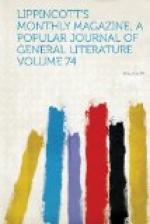Of its treasures of literary and artistic interest it is impossible to give categorical details. Perhaps the library prizes most the magnificent elephant folio edition, in four volumes, of Audubon’s “Birds and Quadrupeds of North America,” with its colored plates, heavy paper, and general air of sumptuousness. The work is rare as well as magnificent, and, though the library does not set a price upon its books, it is known that three thousand dollars would not replace a missing copy. In an adjoining alcove is an equally sumptuous but more ancient volume, the Antiphonale, or mammoth manuscript of the chants for the Christian year. This volume was used at the coronation of Charles X., King of France. The covers of this huge folio are bound with brass, beautiful illuminations by Le Brun adorn its title-pages, and then follows, in huge black characters, the music of the chants. In its immediate vicinity are many of the treasures of the library,—Zahn’s great work on Pompeii, three volumes of very large folios, containing splendidly-colored frescos from the walls of the dead city; Sylvester’s elaborate work of “Fac-Similes of the Illuminated Manuscripts of the Middle Ages,” in four large folios; and also Count Bastard’s great work on the same, seeming more sumptuous in gold, silver, and colors. Another notable work is Count Littar’s “Genealogies of Celebrated Italian Families,” in ten folio volumes, emblazoned in gold, and illustrated with richly-colored portraits finished like ivory miniatures.




